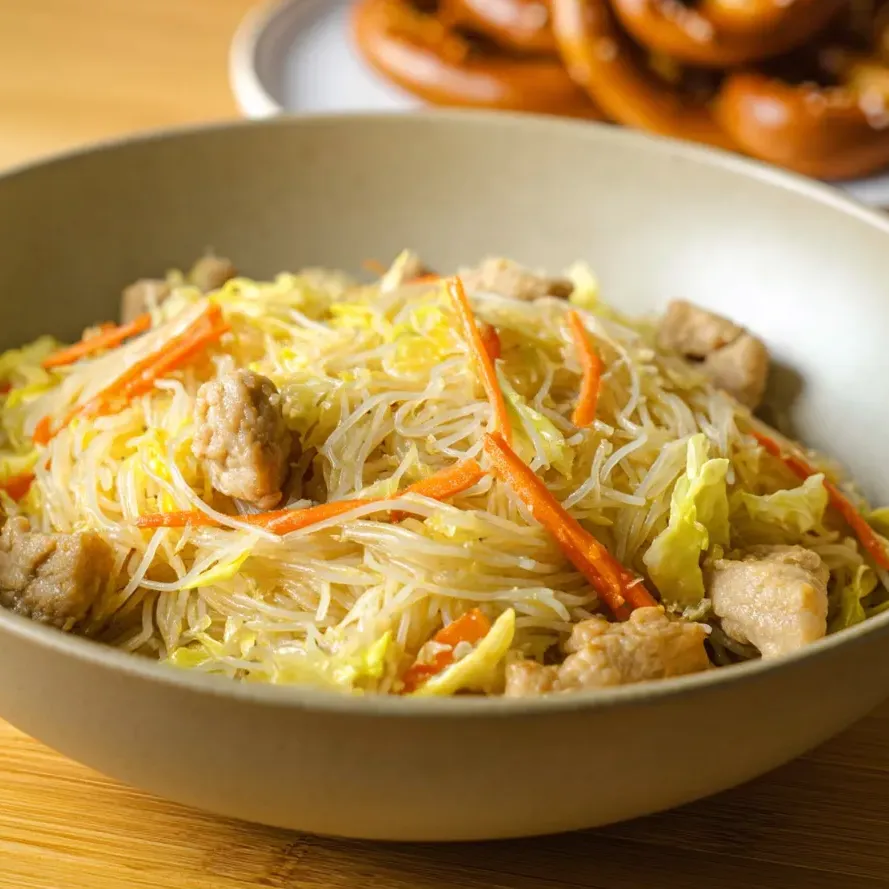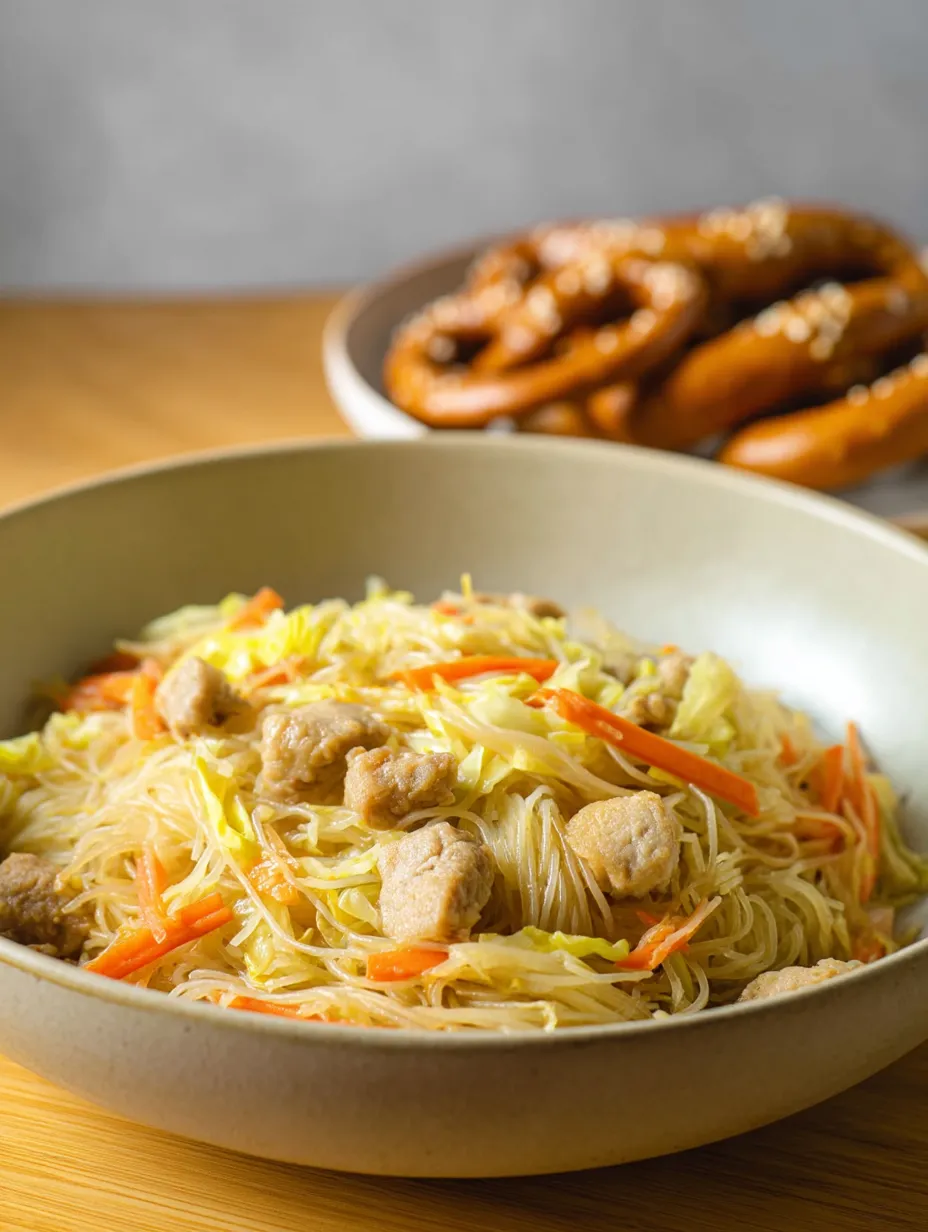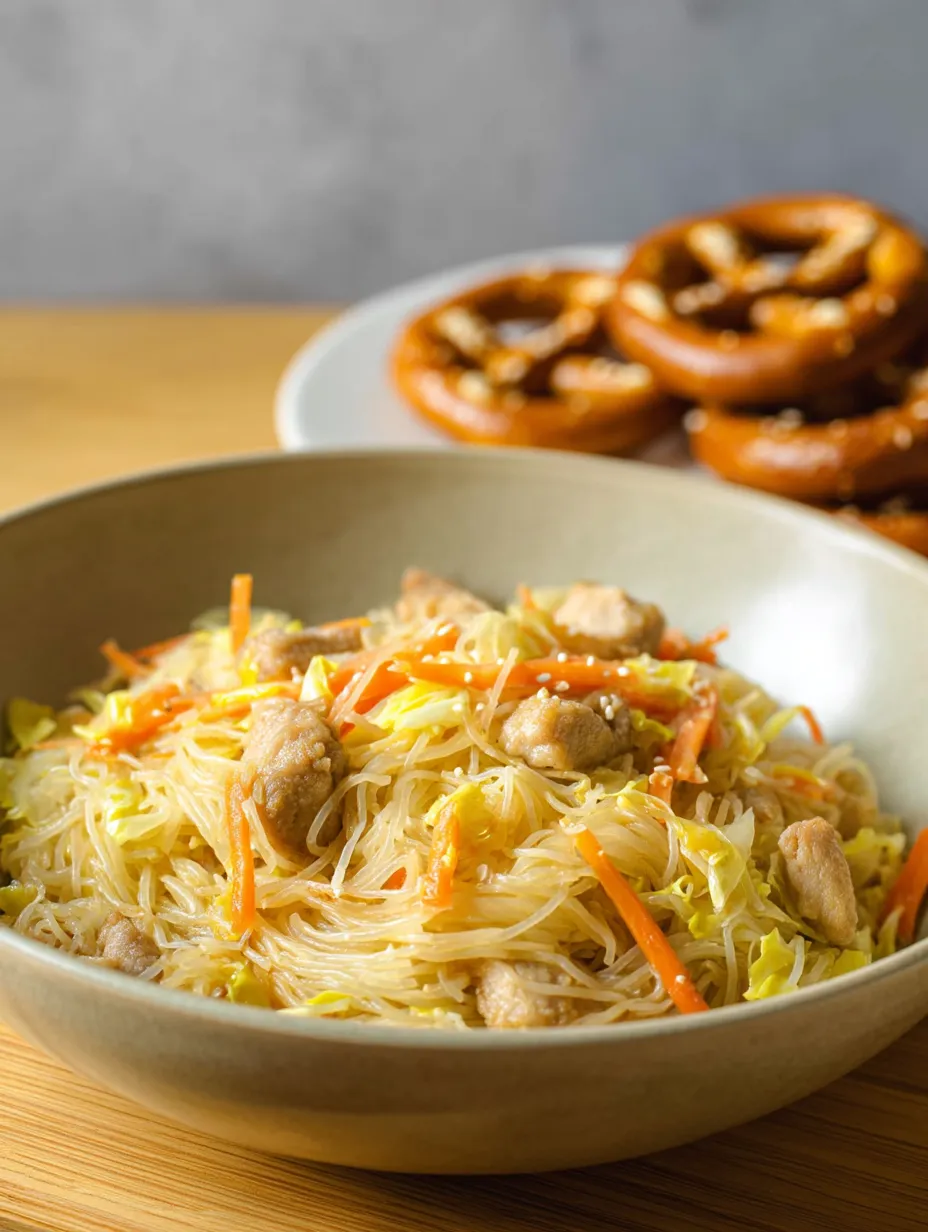 Save
Save
This comforting Filipino Pancit has been my go-to recipe whenever I want to bring a taste of Filipino culture to my dinner table. The combination of silky rice noodles, savory meat, and crisp vegetables creates a perfect balance of textures and flavors that never disappoints.
I first learned to make Pancit from my Filipino neighbor who insisted that this dish brings good luck and long life. Since then, it has become our family tradition to prepare this for birthdays and special occasions.
Ingredients
- 8.8 ounces Thai Vermicelli rice noodles: provides the authentic base for this dish with their delicate texture that absorbs all the flavors
- 2 tablespoons canola oil: use any neutral oil with a high smoke point for proper stir-frying
- 1 pound meat chops: traditional recipes often use pork but chicken or shrimp work beautifully too
- 1 yellow onion: diced finely for a sweet aromatic foundation
- 6 cloves garlic: minced gives essential flavor depth that Filipino cuisine is known for
- 2 tablespoons soy sauce: provides the umami saltiness and beautiful color to the noodles
- 1 cup chicken stock: creates the flavorful liquid that the noodles will absorb
- 2 cups shredded cabbage: adds crunch and subtle sweetness when cooked briefly
- 1/2 cup sliced carrots: brings color and nutritional value to the dish
- 3 green onions: diced adds a fresh finish and pop of color
- Kosher salt and cracked pepper: to taste for final seasoning adjustments
Step-by-Step Instructions
- Prepare the Noodles:
- Soak the Thai Vermicelli rice noodles according to package directions until they become pliable but still slightly firm. The noodles will continue cooking when added to the wok later. Drain well and set aside. Be careful not to oversoak as they can become mushy.
- Prep the Ingredients:
- Cut the meat into uniform bite-sized pieces to ensure even cooking. Dice the yellow onion, mince the garlic, and prepare all vegetables before heating your wok. Having everything ready makes the stir-frying process smooth and prevents overcooking.
- Cook the Protein Base:
- Heat canola oil in a large wok or sauté pan over medium-high heat until shimmering. Add the meat pieces, diced yellow onion, minced garlic, and soy sauce. Stir-fry for 3-5 minutes until the meat is browned and cooked through. This creates a flavorful foundation for your Pancit.
- Add Vegetables and Liquid:
- Pour in the chicken stock and immediately add cabbage, carrots, and green onions. Maintain medium-high heat and cook for 3-5 minutes, stirring frequently. The vegetables should soften but still retain some crispness for textural contrast. The stock will reduce slightly and concentrate in flavor.
- Combine and Finish:
- Add the soaked rice noodles to the wok with the meat and vegetable mixture. Using tongs or two large spoons, gently toss everything together until the noodles are fully coated with the sauce and heated through. Season to taste with salt and pepper. The noodles should absorb most of the liquid and be glossy but not swimming in sauce.

My favorite part of making Pancit is watching how the noodles transform as they absorb all the savory flavors from the meat and vegetables. My children now recognize the distinctive aroma that fills our kitchen whenever I prepare this dish, rushing in to help with the final stirring.
Storage and Reheating
Pancit keeps well in an airtight container in the refrigerator for up to 3 days. The noodles may absorb more liquid as they sit, so when reheating, add a small splash of chicken stock or water to refresh the dish. For best results, reheat in a pan over medium heat rather than using a microwave, which can make the noodles soggy. Stir frequently while reheating to ensure even warming and to preserve the varied textures.

Ingredient Substitutions
This recipe welcomes adaptation based on what you have available. Rice vermicelli is traditional, but other thin noodles like bean thread or even thin spaghetti can work in a pinch. For a vegetarian version, omit the meat and use vegetable stock instead of chicken stock, adding tofu or more vegetables for substance. Any quick-cooking vegetables work well cabbage can be substituted with bok choy, and snow peas or bell peppers make colorful additions. The key is maintaining the balance between noodles, protein, and vegetables.
Cultural Significance
Pancit is more than just a delicious meal in Filipino culture it represents longevity and good fortune. Served at almost every celebration, especially birthdays, the long noodles symbolize a long life. The dish showcases the multicultural influences in Filipino cuisine, with Chinese cooking techniques merged with local ingredients and Spanish influences. Each region in the Philippines has its own variation, with Pancit Canton featuring wheat noodles and Pancit Bihon using rice noodles like in this recipe. Sharing Pancit is a way of sharing good wishes and prosperity with loved ones.
Frequently Asked Questions
- → What type of meat works best for Filipino Pancit?
While this particular version uses meat chops, Filipino Pancit is incredibly versatile. Traditional options include pork, chicken, or shrimp. For a vegetarian version, you can omit the meat entirely and add more vegetables or include firm tofu for protein. The key is cutting whatever protein you choose into uniform, bite-sized pieces to ensure quick and even cooking.
- → Can I prepare Filipino Pancit in advance?
Yes, you can prepare elements of Pancit in advance, but it's best served fresh. You can slice all vegetables and meat ahead of time and store them separately in the refrigerator. The noodles should be soaked just before cooking to maintain their texture. If you need to make the entire dish ahead, store it refrigerated and reheat gently with a splash of water or broth to refresh the noodles.
- → What vegetables can I substitute in Pancit?
Pancit is flexible with vegetables. Beyond the cabbage, carrots and green onions in this version, you can add snow peas, bell peppers, bean sprouts, celery, bok choy, or mushrooms. The key is maintaining a balance of colors and textures while cutting everything uniformly for even cooking. Many Filipino families have their own traditional vegetable combinations based on regional preferences.
- → Why are my Pancit noodles clumping together?
Noodle clumping typically happens when they're oversoaked before cooking or not properly drained. Make sure to follow package directions exactly when soaking the vermicelli rice noodles, and drain them thoroughly. Adding a small amount of oil to the soaked noodles before adding them to the wok can help prevent sticking. Also, use tongs or two utensils to continuously toss the noodles with the other ingredients while cooking.
- → What sauces traditionally accompany Filipino Pancit?
Filipino Pancit is often served with calamansi or lemon wedges on the side, allowing diners to add a fresh citrus accent to taste. Some people enjoy adding a dash of fish sauce (patis) or additional soy sauce. For those who enjoy heat, a side of Filipino vinegar with chilies (suka at sili) makes a traditional accompaniment. Small dishes of these condiments allow everyone to customize their Pancit to personal preference.
- → Is Pancit gluten-free?
This Pancit recipe can easily be made gluten-free by substituting regular soy sauce with gluten-free tamari or coconut aminos. The Thai vermicelli rice noodles are naturally gluten-free, but always check packaging to ensure they're processed in a gluten-free facility if you have celiac disease or severe gluten sensitivity. With these simple adjustments, Pancit becomes a delicious gluten-free option that maintains all its traditional flavor.
